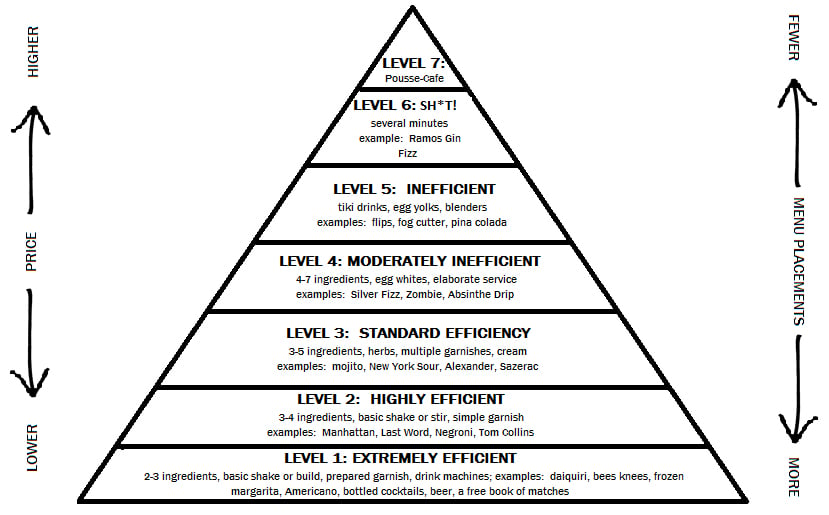

Pictured: Bobby Heugel (left) and Terry Williams (right)
Determining pricing for cocktails, a seemingly basic process in the bar business, can be far more difficult than anyone would imagine. What happens if you’re preferred gin doesn’t come in on today’s liquor order? What if citrus prices skyrocket? What if you work in a market where the ceiling doesn’t allow for double-digit cocktail prices? Bobby Heugel, Owner of Anvil Bar & Refuge and his General Manager, Terry Williams, presented a seminar at that broke down the cost of a cocktail, every step of the way.
Bobby broke down primary costs into three categories: Juice & produce, syrup & similar and service items. They outlined several tips for reducing costs as follows:
Juice & produce
· Buy sized limes for garnish and buy packer limes for juicing
· Take weekly prices from various distributors before buying if you're a small operation or only buy for one bar program
· Buy in bulk through discount congrats or group orders for multiple bars programs
· Buy produce in futures if you go through enough of it. Most bar groups with 6-8 or more establishments rotate as much citrus daily as a grocery store, which buys wholesale in futures
Syrup & Similar
· Undertake easily prepared ingredients during bar shifts
· Produce perishable ingredients in smaller qualities to avoid waste
· Produce stable ingredients in larger quantities to reduce labor costs
· Consider not making everything in house… There's some incredible bottled products made by folks who probably make a better orgeat than you do
Service Items
· Buy glassware in bulk and store it for extended periods of you can afford to do so. Otherwise, group order with other bars (buy by the pallet and keep in storage of you can afford it)
· Pursue non-traditional glassware sources like alibaba.com
· Avoid items that people who are intoxicated are likely to steal
· Seriously question if your desires for everything to be as pretty, branded or durable as possible matches with your guests' expectations for pricing, advertising or quality
Next, they split secondary costs into three categories: Price variances, margin of error, spills and waste, and service labor. Bobby used happy hour as an excellent example for a price variance:
Standard Daiquiri recipe
2 oz Plantation 3 star rum = $0.82 (oz cost x 2)
.75 oz lime juice = $0.18 (oz cost x .75)
.25 oz simple syrup = $0.06 (oz cost x .25)
1 lime wedge =$0.02 (lime wedge cost)
1 beverage napkin = $0.02
Glassware service cost = $0.07
| TOTAL PRIMARY COSTS = $1.17 | HAPPY HOUR PRICE = $5.00 |
| COCKTAIL PRICE = $8.00 | HAPPY HOUR COST % = $23.40 |
| TOTAL COST OF GOODS SOLD % = 14.625% | NET PER COCKTAIL = $3.83 |
| NET PER COCKTAIL = $6.83 | |
| $6.83 - $3.83 =$3.00 (loss). $3.00/$3.83 = 78% (break even %) | |
Therefore, the daiquiri happy hour must generate a 178% increase in sales to net the same profits that the bar would at standard pricing.
Margin of Error, Spills and Waste breaks down as follows:
1. Ratio measurement: free pouring vs. jiggers
a. Free pouring = more efficient during rushes, higher margin of error, better for high volume environments like nightclubs
b. Jiggers = less efficient during rushes, lower margin of error, better for slower-paced, product-focused cocktail bars
2. Spills & waste: mispours, guest mistakes, guest dislikes, etc.
3. Drink development: cost of cocktail, creation & training
4. Complimentary drinks: rewards for regulars
As for service labor, Bobby developed “Heugel’s Hierarchy of Cocktail Weeds” in order to explain the importance of having time consuming cocktails on your menu at a higher price point vs. more efficient cocktails at a lower price point.

Finally, Bobby broke down the ethics of pricing for spirits and cocktail sales.
Spirits Sales
1. Cost % models: consistent scales vs. progressive scales
a. Consistent scale – guests pay a flat percentage markup that maintains a consistent cost of goods sold % regardless of pricing
b. Progressive scale – guests pay a sloping percentage markup that is higher for lower-priced items and lower for higher-priced items
The ethical concerns that were raised included:
· Is it fair to reward the wealthy for spending more?
· Is it the obligation of the bar operator to be consistent within the confines of either chosen cost % model?
· Should the bar owner favor certain brands by increasing the cost % of the spirits sold to make them more attractive to guests?
Cocktail Sales
1. Cocktail menu models: Consistent prices vs. individual prices
a. Consistent prices = all cocktails maintain a consistent price regardless of cost of goods sold % for serving the drink, i.e. “ALL DRINKS $12”
b. Individual prices = all cocktails are priced independently according to the cost of goods sold % or subjective decisions of the house, i.e. different prices for each drink
Ethically speaking, Bobby asked, “Is it fair for the person having a vodka cocktail, which costs the bar $1.53 to serve, to pay the exact same price as the Sazerac drinker with more ‘street cred’ who opts for a cocktail that costs $2.53 to serve?”
This raised a heated discussion in the classroom because many bartenders felt that if someone was willing to pay, then what was the big deal? However, Bobby urged that people remember what’s ethical. Again, he asked, “Do bar owners regularly take advantage of less-savvy consumers by serving them a less valuable cocktail for the same or higher prices than more valuable cocktails?”
Want more information on costing out your cocktail or our cost? Make sure to attend the 2016 Nightclub & Bar Convention and Trade Show to get all the questions you have answered. Registration now open at www.ncbshow.com.
